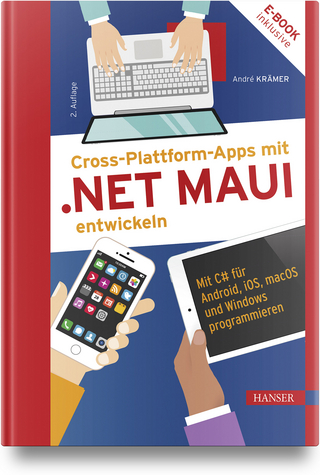
Practical Bot Development
Apress (Verlag)
978-1-4842-3539-3 (ISBN)
- Learn to build and publish bots using the Microsoft Bot Builder Framework
- Utilize your existing Node.js skills to build great bot experiences
- Real hands on bot development for beginners
Explore the concept of bots and discover the motivation behind working with these new apps with messaging platforms. This book is an accessible resource teaching the basic concepts behind bot design and implementation.
Each chapter builds on previous topics and, where appropriate, real working code is shown that implements the concepts. By just picking up a code editor, you can start creating smart, engaging, and useful bot experiences today.
Practical Bot Development will teach you how to create your own bots on platforms like Facebook Messenger and Slack, incorporate extension APIs, and apply AI and ML algorithms in the cloud. By the end of this book, you'll be equipped with the information to reach thousands of new users with the bots you create!
The book is a great resource for those looking and harness the benefits of building their own bots and leveraging the platform feasibility of them.
- Understand the general architecture of a bot
- Distinguish between a great bot experience versus a bad bot experience.
- Explore the ideas behind natural language processing and apply them to bot development
- Implement real Messenger, Slack, and custom channel bots using Node.js and the Microsoft Bot Builder framework
- Deploy bots to Facebook Messenger and Slack
This book is for Engineers, hobbyists, and the design oriented community looking looking for an introduction to the technologies and concepts involved in building bots. The experience level could be from beginner to expert, although some familiarity with Node.js and APIs will be assumed.
Szymon Rozga has worked in the software development space for over 14 years taking a shot at everything from Rails to C to Java to Python to .Net. He found a passion working on Windows Desktop trading applications on Wall Street with a focus on the front end user experience. The interest in attention to user interface details would take him on a tour of the different UI technologies on the Windows, Web and iOS/Android platforms. He enjoys leading deep discovery sessions and scoping solutions for his clients. Szymon has managed teams of engineers on a variety of projects and can be commonly found leading engagements, mentoring junior engineers (another passion of his) and collaborating on building team engineering capacity in emerging technologies. Starting in 2016, Szymon has spent all his time dedicated to building bots for clients whether the bot runs on a mobile app, the web or a messaging platform. He has built a practice around the technology and is involved in a handful of bot projects at any time. He has a passion for paying attention to conversational experience details and is a big proponent of getting your bot to do a few tasks really well. He has a deep interest in all things Machine Learning and Artificial Intelligence. In his spare time he enjoys walking in nature, relaxing on the beach, playing guitar and spending time with his wife Kimberly, his son Theodore and his dog Chelsea. He's an avid reader, especially of things completely unrelated to software development.
Chapter 1: Introducing Bots
Motivation: apps vs bots and interacting with computers using Natural Language Interfaces. Google Now, Siri, Alexa. Great progress in recent years in both translation, voice recognition and natural language understanding technologies. Democratization of AI and Machine Learning APIs. Bots as a new way of implementing user interfaces.
Use Case: describe a bot to help users order tickets
Use it to describe the following concepts:
Natural language recognition
Text conversations
Rich media conversations
Bot-led conversations
Human hand off
Embedding into messaging apps
Chapter 2: Bot User Design (UX)
Motivation: there is a good way for bots to communicate to you and there is a bad way. This chapter will distill some common "good" approaches to a bot and Also show some examples of bad communication.
conversational User Experience
Text vs rich conversations
Bot initiated conversations
Perceived performance
Personalized content
Concise and clear messaging
Consistent voice
Do one thing well, provide value
Chapter 3: Natural Language Understanding
Motivation: part of the reason bots are becoming a thing is that natural language recognition technologies are widely available and easier to use.
Intent classification
Entity Extractors - Named Entity Extraction
LUIS
How to create a model
How to train LUIS to recognize intents and entities (use ticket ordering bot as a use case)
Action Fulfillment - not used in LUIS anymore, but still used in cloud based, intent-led bot frameworks. It is interesting to know when creating bots.
Chapter 4: Introducing Microsoft Bot Builder Framework
Motivation: cloud bot services vs bot as a web service models. We favor bot as a web service model for ease of use, control, extensibility etc.
MSFT bot builder framework - what is it?
Node.js and why we use the Node.js version vs the C# version
Core concepts
Intro to emulator
Node.js samples
How to run sample
Some basic bot samples
Chapter 5: Dive into Bot Builder
Motivation: we need to go over the different concepts inside the bot builder framework and how they help us build bots.
Dialogs
Messages
Connector
Channels
Conversation State
Recognizers
Actions
Proactive messages
Chapter 6: Putting it all together
Motivation: Build a sample bot that uses all of the concepts in the previous chapter
Back to ordering tickets bot - lots of coding
Chapter 7: Advanced bot builder topics
Motivation: Expand sample from #6 with some more advanced concepts like proactive messaging, better dialog management, custom recognizers, deeper action support, group chats, etc.
Lots of code here
Chapter 8: Deploying to Channels and sending custom data
Motivation: a bot is useless unless it is connected to a channel. Let's see how this is done. We introduce the bot framework web site.
Focus on Messenger and Slack
Show some custom functionality such as messenger square cards or slack updating messages
Chapter 9: Custom channels
Motivation: sometimes you would like to support a custom channel that is not supported out of the box by Microsoft. How do we do this?
Using direct line
Using vanilla bot builder interfaces
Chapter 10: Making the Bot smarter
Motivation: there is a lot of easy to use AI/ML services out there. What are they and how can they help our bot be smarter.
Vision
Emotion
Language Detection
Sentiment
Linguistic Analytics
QnA Maker
Why use these? Why not use these services? What is the goal of your bot?
Chapter 11: Communicating using Custom Graphics
Motivation: rich content and graphics can better capture information than plain text using dynamically generated images
Adaptive Cards - adaptivecards.io - one option, easier to deal with
Custom HTML generation - generate images from html using PhantomJS on the server
Chapter 12: Human Handoff
Motivation: customers want to keep in touch with your brand, what happens when a human is needed?
Chapter 13: Logging and Bot Analytics
How do we log data?
What are the interesting measures that we look for in a bot?
What systems are out there and what can they can us figure out about our customers and bots?
Chapter 14: Other bot implementation platforms
Brief overview of the technology field: Api.ai, wit.ai, IBM conversation, amazon, etc.
Goal of this chapter will be to demonstrate that these frameworks have very similar approaches in terms of NLU, conversation management, state, etc. Knowledge from this book will allow you to develop using the other systems.
| Erscheinungsdatum | 12.09.2018 |
|---|---|
| Zusatzinfo | 302 Illustrations, black and white |
| Verlagsort | Berkley |
| Sprache | englisch |
| Maße | 155 x 235 mm |
| Gewicht | 1015 g |
| Einbandart | kartoniert |
| Themenwelt | Mathematik / Informatik ► Informatik ► Netzwerke |
| Informatik ► Programmiersprachen / -werkzeuge ► NET Programmierung | |
| Mathematik / Informatik ► Informatik ► Software Entwicklung | |
| Informatik ► Theorie / Studium ► Künstliche Intelligenz / Robotik | |
| Schlagworte | Artificial Intelligence • BOT • Building a bot • Conversational Intelligence • Conversation Design • Luis.ai • Messenger Send API • Microsoft Bot Builder Framework • Natural Language Processing • Slack Message API |
| ISBN-10 | 1-4842-3539-8 / 1484235398 |
| ISBN-13 | 978-1-4842-3539-3 / 9781484235393 |
| Zustand | Neuware |
| Informationen gemäß Produktsicherheitsverordnung (GPSR) | |
| Haben Sie eine Frage zum Produkt? |
aus dem Bereich


